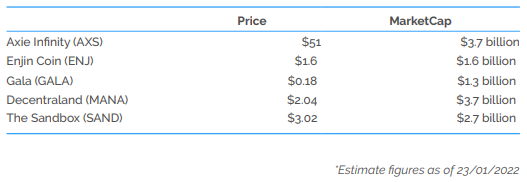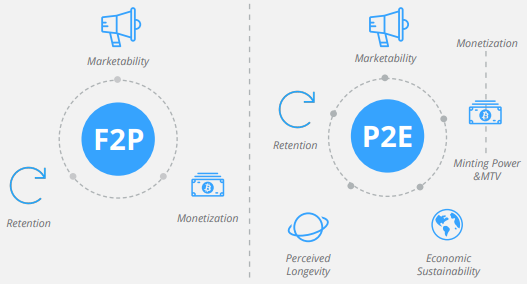THE GAMING INDUSTRY
The gaming and metaverse sector is worth billions of dollars and it is growing. Nearly 50% of active cryptocurrency wallets connected to decentralized applications in November 2021 were for playing games, according to crypto data tracker DappRadar. The number of wallets relating to gaming activity increased by 2,453%, from 29,563 during the first week of 2021 to 754,000 in Q3 2021 and around 80-100 million transactions are occurring in blockchain-based games daily.
EarthWeb reports that the metaverse market is expected to be worth $280 billion by 2025, while it was worth just $46 billion in 2020. There is a lot of financial gain to be found in the gaming sector of blockchain technology which has manifested itself through the appreciation of gaming tokens such as AXS which saw an annual growth greater than 17000% in 2021. Beyond creating and trading in-game assets in line with the Play-2-Earn model, blockchain gamers also rent out assets, stimulating what has become a virtual economy. As this trading of virtual assets continues to grow, it also becomes increasingly accessible. This is why businesses such as Lootex, which is a multi-chain NFT marketplace based around the trading of gaming and metaverse assets closed on $9 million of seed funding in January 2022.
The Blockchain Game Alliance reported blockchain gaming having earned $2.3 billion in 2021 third-quarter revenue, making up 22% of all NFT trading volume in this period. The Game Finance market has grown massively with the top 10 gaming tokens by market capitalization making up upwards of $20 billion in market cap, the top 5 all being worth more than $2 billion each. (As of 14 January 2022).
Multiple companies have expressed their intention to develop their exposure in the metaverse include Meta (Formerly Facebook), Google, Microsoft, Roblox and NVIDIA amongst others. While these companies’ intentions for the metaverse are beyond gaming, public perception of the metaverse is largely focused on gaming for the time being. DappRadar predicts about 70 new blockchain-based crypto games to go online monthly.
The Play 2 Earn market has grown exponentially especially throughout 2021. 3 of the major platforms in this sector that reflect this growth are Axie Infinity, Decentraland, and CryptoKitties.
Axie Infinity recently raised $152 million in Series B funding. The currency used in Axie Infinity is AXS which was priced at about $72 as of 7 January 2022 making up a market cap of $4.4 billion. In late October 2021, Axie Infinity was projected to generate annual revenue of $1.2 billion. Since the company’s founding, their total revenue exceeds $2.3 billion and recorded more in August 2021, there was 1.8 million daily active users.
Crypto Gaming Initiated a New Paradigm Shift
The perfect combination of blockchain and gaming has never been realized in recent years. However, once people saw the play-to-earn concept in action, everything changed. Games can provide income sources for players that were never conceivable in traditional free-toplay games by utilizing blockchain technology. Take, for example, a PVP game like Fortnite. Epic Games, the game's creator, now has authority over everything a player owns through in-game purchases. You can show off a new skin for your gun, but you don't have genuine ownership of your possessions. You won't be able to trade or exchange your assets with other players while Epic Games takes the entire annual revenue pie.
Play-to-earn games demonstrated to the world why crypto gaming is the way of the future. Players regain control of their assets and have the ability to determine the in-game economy by utilizing cryptocurrency and blockchain technology.
Play-to-earn: Emerging Model of Gaming
Gaming-based monetization is not a new concept. We see million-dollar sponsorship deals for best athletes, but that is not play-to-earn. All games can engage in P2E games and earn virtual money for reaching certain milestones.
Earning from item swaps or selling is prohibited in the traditional game model. People used to sell high-level accounts in World of Warcraft when it was the pinnacle of gaming. However, the developers promptly banned them and froze their accounts, effectively halting all transactions. This amount of domination and authority is not provided to any individual in play-to-earn. In the network, all players and network participants are equally rewarded. And it's because of this that it's so unique.
In a P2E game, participants get value in the form of NFTs and in-game currency. Players can exchange their NFTs on secondary marketplaces since blockchain enables full ownership and total transparency. In-game currencies are also beneficial to players because they serve to fuel the entire ecosystem.
Players can sell their in-game assets for better prices as they level up and gain more in-game assets on the NFT marketplace. Players can also generate steady cash flows in the form of rent in some games. As a result, owning virtual real estate is extremely beneficial for gamers who are unable to devote the majority of their time to gaming
What function does blockchain technology play in the cryptocurrency gaming industry?
Although the underlying technology varies from game to game, they all provide similar features. To begin, blockchain technology improves in-game asset ownership, and smart contracts handle transactions on the primary or secondary market. Blockchain technology is also used to create the trading platform. It also has a superb user interface that makes trading tokens and other assets a breeze.
Second, blockchain-based platforms make payment procedures more safe and automated. Without incurring exorbitant fees, players may cash out their prizes and convert them into useable cryptocurrencies or stablecoins right away. Finally, blockchain technology aids gaming platforms in scaling and lowering entry barriers, allowing anyone to play.
NFTs - The Missing Piece of the Puzzle
In the play-to-earn metaverse, in-game tokens are a component of a larger income model. NFTs are where players may truly accumulate value. We've seen an unfathomable history of sales and floor prices on some of these top NFT collections, since 2021 is the year for nonfungible tokens. To top it off, Facebook's rebranding to "Meta" increased investor confidence in the long-term worth of NFTs and how important they are to the metaverse.
A game's NFTs are not restricted to a single metaverse. Once completely functional, they can be used cross-chain and deployed in many virtual worlds. Collections like Bored Ape Yacht Club, for example, have gone parabolic this year. With a current floor price of 50 ETH, the lowest Bored Ape is valued more than $200,000. In a metaverse game, these avatars or PFP characters can be employed.
Returning to the revenue model, virtual real estate, game assets such as weaponry, and uncommon game characters such as Mystic Axie in Axie Infinity are also examples of NFTs. Players can occupy their virtual land and sell it for a greater price in-game or on the NFT marketplace OpenSea.
Last updated

